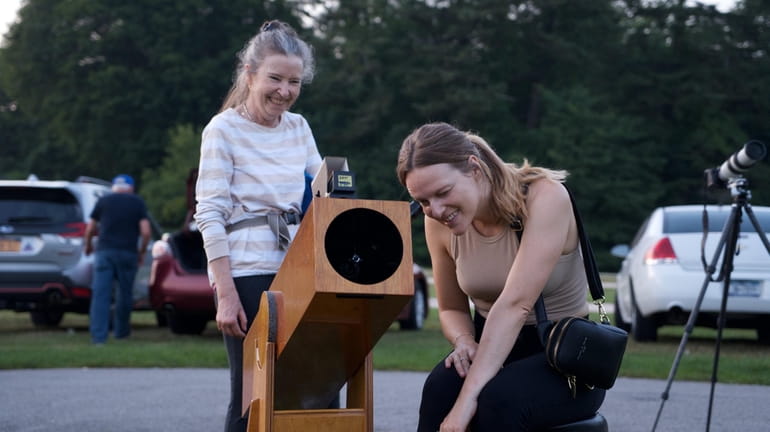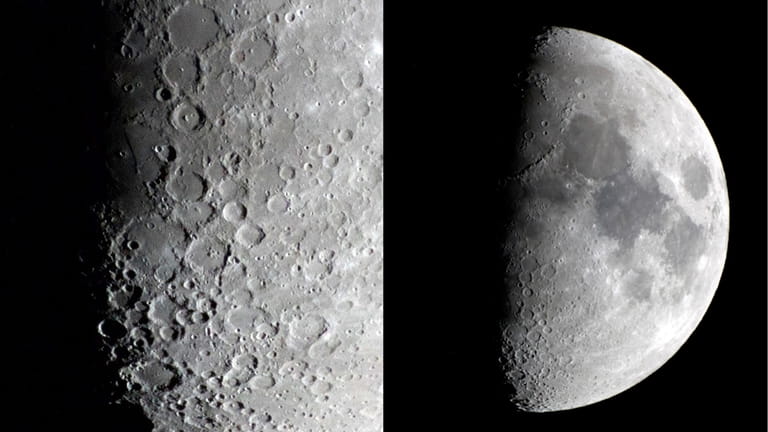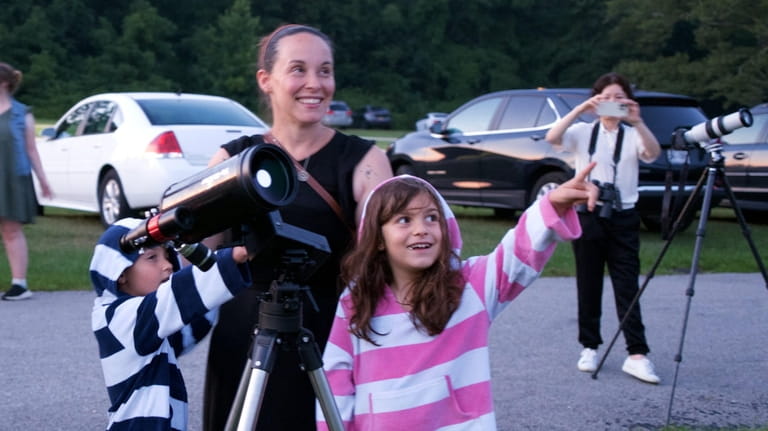Meteor showers visible from Long Island and other celestial events to catch

Eleonora Kuenzel and her daughter Anita of Sea Cliff look up at the sky at Old Westbury Gardens on July 28. Credit: Ken Spencer
Otherworldly light travels a long way to reach Earth, where astronomer Dave Bush guides viewers peering through telescopes at the Vanderbilt Observatory in Centerport.
“My hope is to have people actually connect to the stars,” says Bush, director at the Vanderbilt Museum and Planetarium. “When you look through a telescope, your eyes are actually capturing tiny photons that are emitted either directly from stars or reflected off objects, like planets and the moon. That photon enters your retina … In that way, we are physically touching the stars when we look through the telescopes.”
So cosmic.
Long Island shines with its observatories and telescopes accessible to the public. Sky watchers can take their pick, from telescopes on a rooftop to an observatory started by the man who helped make the Hubble Space Telescope.
With humidity on the decline, fall and winter are great times to look up, says Steven Bellavia, an aerospace engineer and senior staff volunteer at Custer Institute and Observatory in Southold. “The nights are longer and the skies are clearer, usually,” he explains.
Celestial events visible from Long Island

Members of the Astronomical Society of Long Island set up telescopes so visitors could observe the moon in Westbury on July 28. Credit: Ken Spencer
Upcoming astronomical events range from meteor showers to celestial objects appearing so close to each other that they can be viewed together through a telescope. One standout: Saturn and Jupiter, our solar system’s largest planets, are at their closest points to Earth for the rest of the year, but what makes the viewing special is they’re also at their brightest. That’s because they are in “opposition” to our planet, which means Earth is between them and the sun, giving humans a view of the large orbs bathed in sun rays.
Also check out the Perseus constellation Double Cluster, two groups of stars that are close in astronomical terms, each with more than 300 blue-white supergiant suns and a sprinkling of orange ones. They’ll be high up for a better view.
“It’s like looking at jewels,” Bellavia says.
To boost chances of seeing the universe, pick nights when the sky is clear:
- Late October to early November: Double Cluster, blue-white and orange supergiant stars, will be high in the sky, away from the horizon’s light pollution.
- Nov. 1-3: Jupiter will be at its brightest and closest to Earth for the year, but this planet and Saturn will remain major bright points in the sky through December.
- Nov. 19- Dec. 24: Geminid meteor showers, an annual favorite due to their prolific number of “shooting stars,” are active and peak Dec. 14. This year, New York’s part of the planet will be facing Geminid for a full frontal view, on top of darker skies due to a new moon.
- Jan. 18: Jupiter and the moon will appear close to each other, 3 degrees apart.
- Jan. 27: Mercury and Mars will appear extremely close in the sky, about .12 degrees apart, considered a rare sight.
Where to go for an unobstructed view of the sky

Rachel Lubertine, her son James, 5, and daughter Ava, 7, view the first quarter moon at Old Westbury Gardens. Credit: Ken Spencer
Cluster Institute and Observatory
1115 Main Bayview Rd., Southold
Custer has the observatory of most people’s imaginations — a high-up, large dome that opens and turns so a telescope can poke into the night air.
The main telescope is a 10-inch diameter Zerochromat, which corrects color aberrations of light waves going through glass lenses, revealing the truer colors of celestial objects, Bellavia says.
In one exhibit, the basement still has the lens grinding machines used by institute co-founder Charles Elmer to make his own telescopes there; he later nabbed the Hubble contract as co-founder of Perkin-Elmer Corp.
Two observatories on the grounds, each the size of a hut, are often open to the public, one owned by the Amateur Observers Society of New York and the other by the Astronomical Society of Long Island.
When: 8 p.m. to midnight Saturdays
Cost: Suggested donation of $5 adults, $3 children
Hofstra Observatory
Herman A. Berliner Hall, 826 Huntington Place, Uniondale
In the open air of a Hofstra University rooftop, astronomer Donald Lubowich trains telescopes on only about 50 celestial objects because everything else is too far to fascinate visually.
Visitors can see how a small electronic telescope, one without a view piece, snaps several shots of a galaxy as far as 4 million light years away (one light year is 6 trillion miles) and sends clear images to Lubowich’s iPad by “stacking” the photos. For example, the spiral arms of Andromeda, the closest galaxy, are visible.
“You can see structures in galaxies,” says Lubowich, the astronomy outreach coordinator.
When: 7-9 p.m. first Sunday of every month
Cost: Free, registration required
More info: hofstra.edu/physics-astronomy/observatory.html
Hamptons Observatory
18 Goodfriend Dr., Ross School campus, East Hampton
Appointments are required for this 20-inch, research-grade telescope, the first one made by a company that wanted to cater to amateur astronomers, says observatory co-founder Terry Bienstock, a former cable executive.
His idea to get a telescope took years of work, aided by the publicity from supermodel Christie Brinkley and other celebrities who lived in the area and wanted fun educational options for children.
The observatory holds “star parties” — a traveling show with planetarium and telescopes — in the community and on demand at events.
“When they see Saturn’s rings,” says Bienstock, 69, of Sound Beach, “their mouths drop open.”
When: By appointment
Cost: Free
More info: hamptonsobservatory.org
Old Westbury Gardens
71 Old Westbury Rd., Old Westbury
Members of the Astronomical Society of Long Island bring their telescopes and point them at the moon and planets.
Society president Ken Spencer considers the quarter moon to be a superb time to visit, saying that’s when the sunlight casts shadows, making craters more visible.
Many viewers fall silent after seeing a part of the universe, notes Spencer, of Sea Cliff: “It’s life-changing.”
When: 7-9 p.m. third Thursday of each month
Cost: Included in admission fee of $15 adults, $8 children
More info: oldwestburygardens.org, asliclub.org
Vanderbilt Museum and Planetarium
180 Little Neck Rd., Centerport
“Can you see footprints on the moon?”
It’s a common question from visitors, says Bush, an astronomer.
But while no footprints will be visible from Earth, the astronomer likes to channel interest to Albireo, a double star system with one blue star and one gold.
“The contrast is stunning,” he says, “and one of the most colorful objects that you’ll see through the telescope.”
When: 8-10 p.m. Fridays, weather permitting
Cost: Free; 7 p.m. planetarium show on the night sky is $10 adults, $8 for children 2 and up
More info: vanderbiltmuseum.org
